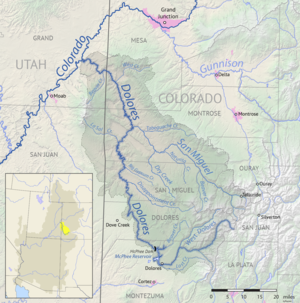This article needs additional citations for verification. (December 2009) |
| Dolores River | |
|---|---|
 Dolores River | |
 The Dolores River watershed | |
| Location | |
| Country | United States |
| State | Colorado, Utah |
| Physical characteristics | |
| Source | San Juan National Forest |
| • location | Montezuma County, Colorado |
| • coordinates | 37°43′18″N 107°52′47″W / 37.72167°N 107.87972°W[1] |
| • elevation | 11,650 ft (3,550 m) |
| Mouth | Colorado River |
• location | Grand County, Utah |
• coordinates | 38°49′00″N 109°16′02″W / 38.81667°N 109.26722°W[1] |
• elevation | 4,390 ft (1,340 m) |
| Length | 241 mi (388 km)[2] |
| Basin size | 4,574 sq mi (11,850 km2)[3] |
| Discharge | |
| • location | Cisco, UT, about 9 mi (14 km) from the mouth[4] |
| • average | 630 cu ft/s (18 m3/s)[4] |
| • minimum | 1.5 cu ft/s (0.042 m3/s) |
| • maximum | 12,900 cu ft/s (370 m3/s) |
| Basin features | |
| Tributaries | |
| • right | West Dolores River, San Miguel River (Colorado) |
The Dolores River is a tributary of the Colorado River, approximately 241 miles (388 km) long,[2] in the U.S. states of Colorado and Utah. The river drains a rugged and arid region of the Colorado Plateau west of the San Juan Mountains. Its name derives from the Spanish El Rio de Nuestra Señora de Dolores, River of Our Lady of Sorrows. The river was explored and possibly named by Juan Maria Antonio Rivera during a 1765 expedition from Santa Fe.
The mean annual flow of the Dolores prior to damming was approximately 1,200 cu ft/s (34 m3/s), but due to diversions it has been reduced to about 600 cu ft/s (17 m3/s).
- ^ a b "Dolores River". Geographic Names Information System. United States Geological Survey, United States Department of the Interior. Retrieved 2011-01-27.
- ^ a b "USGS National Atlas Streamer". United States Geological Survey. Archived from the original on 28 May 2014. Retrieved 2015-01-10.
- ^ "Boundary Descriptions and Names of Regions, Subregions, Accounting Units and Cataloging Units". U.S. Geological Survey. Retrieved 2013-01-31.
- ^ a b "USGS Gage #09180000 on the Dolores River near Cisco, UT" (PDF). National Water Information System. U.S. Geological Survey. 1987–2011. Retrieved 2013-01-31.